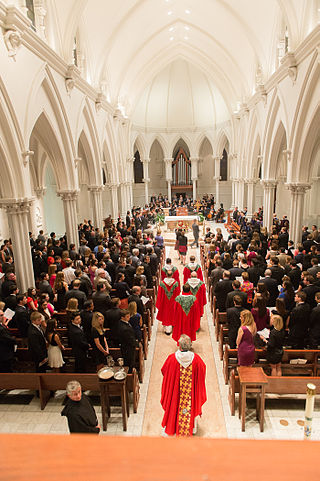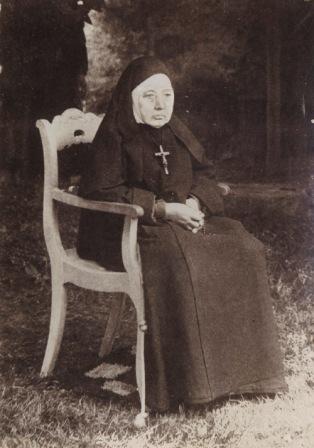
A coronation is the act of placement or bestowal of a crown upon a monarch's head. The term also generally refers to the ceremony which marks the formal investiture of a monarch with regal power. In addition to the crowning, this ceremony may include the presentation of other items of regalia, and other rituals such as the taking of special vows by the new monarch, the investing and presentation of regalia him or her, and acts of homage by the new monarch's subjects. In certain Christian denominations, such as Lutheranism and Anglicanism, coronation is a religious rite. As such, Western-style coronations have often included anointing the monarch with holy oil, or chrism as it is often called; the anointing ritual's religious significance follows examples found in the Bible. The monarch's consort may also be crowned, either simultaneously with the monarch or as a separate event.

A scapular is a Western Christian garment suspended from the shoulders. There are two types of scapulars, the monastic and devotional scapular; both forms may simply be referred to as "scapular". As an object of popular piety, a scapular serves to remind wearers of their commitment to live a Christian life.

A verger is a person, usually a layperson, who assists in the ordering of religious services, particularly in Anglican churches.

The Scapular of Our Lady of Mount Carmel belongs to the habit of both the Carmelite Order and the Discalced Carmelite Order, both of which have Our Lady of Mount Carmel as their patroness. In its small form, it is widely popular within the Latin Church of the Catholic Church as a religious article and has probably served as the prototype of all the other devotional scapulars. The liturgical feast day of Our Lady of Mount Carmel, July 16, is popularly associated with the devotion of the Scapular.
A cowl is an item of clothing consisting of a long, hooded garment with wide sleeves, often worn by monks. It was developed during the Early Middle Ages. The term may have originally referred to the hooded portion of a cloak, though contemporary usage refers to an entire closed garment. A cowl is traditionally bestowed upon the monk at the time of making solemn, or lifetime, profession. Today, it is worn primarily by most Catholic and Anglican monks when participating in liturgical services.

The Passionists, officially named the Congregation of the Passion of Jesus Christ, abbreviated CP, are a Catholic clerical religious congregation of pontifical right for men, founded by Paul of the Cross in 1720, with a special emphasis on and devotion to the Passion of Jesus Christ. A known symbol of the congregation is the labeled emblem of the Sacred Heart of Jesus, surmounted by a cross. This symbol is often sewn into the attire of its congregants.

An enthronement is a ceremony of inauguration, involving a person—usually a monarch or religious leader—being formally seated for the first time upon their throne. Enthronements may also feature as part of a larger coronation rite.

A Red Mass is a Catholic Mass annually offered towards all members of the legal profession, regardless of religious affiliation: judges, lawyers, law school professors, law students, and government officials, marking the opening of the judicial year. The religious service requests guidance from the Holy Spirit for all who seek justice, and offers the legal community an opportunity to reflect on the power and responsibility of all in the legal profession.

The Felician Sisters, in full Congregation of Sisters of St. Felix of Cantalice Third Order Regular of St. Francis of Assisi, is a religious institute of pontifical right whose members profess public vows of and live in common. This religious institute was founded in Warsaw, Poland, in 1855, by Angela Truszkowska, and named for a shrine of Saint Felix of Cantalice, a 16th-century Capuchin especially devoted to children.

There are a number of Roman Catholic religious orders or congregations with Immaculate Conception in their name. Several of them are discussed here.

The Order of the Immaculate Conception, abbreviated OIC and also known as the Conceptionists, is a Catholic religious order of Pontifical Right for nuns founded by Saint Beatrice of Silva. For some years, they followed the Poor Clares Rule, but in 1511 they were recognized as a separate religious order, taking a new rule and the name of Order of the Immaculate Conception.

The Fivefold Scapular, also known as Redemptorist Scapular, is a sacramental made up of five best-known of the early scapulars in the Catholic Church: the Brown Scapular of the Carmelites, the Blue Scapular of the Immaculate Conception, the Black Scapular of the Servites, the Red Scapular of the Passion, and the White Scapular of the Most Holy Trinity. There are 17 total officially approved scapulars of the Catholic Church.

Beatrice of Silva, born Beatriz de Menezes da Silva, was a Portuguese noblewoman who became the foundress of the monastic Order of the Immaculate Conception. Amadeus of Portugal's younger sister, she is honored as a saint by the Roman Catholic Church.

A confraternity is generally a Christian voluntary association of laypeople created for the purpose of promoting special works of Christian charity or piety, and approved by the Church hierarchy. They are most common among Catholics, Lutherans, Anglicans, and the Western Orthodox. When a Catholic confraternity has received the authority to aggregate to itself groups erected in other localities, it is called an archconfraternity. Examples include the various confraternities of penitents and the confraternities of the cord, as well as the Confraternity of the Holy Guardian Angels and the Confraternity of the Rosary.

Three Hail Marys are a traditional Roman Catholic devotional practice of reciting Hail Marys as a petition for purity and other virtues. Believers recommend that it be prayed after waking in the morning, and before going to bed. This devotion has been recommended by SS. Anthony of Padua, Alphonsus Liguori, John Bosco and Leonard of Port Maurice. Two saints, Mechtilde and Gertrude the Great, are said to have received revelations from the Blessed Virgin Mary regarding this practice.

Enthronement is an ancient ceremony that marks the accession of a new emperor to Japan's Chrysanthemum Throne, the world's oldest continuous hereditary monarchy. Various ancient imperial regalia are given to the new sovereign during the course of the rite. It is the most important out of the Japanese Imperial Rituals.
The installation of the Yang di-Pertuan Agong is a ceremony that formally marks the beginning of the reign of the Yang di-Pertuan Agong as the Malaysian head of state.
Coronations in Asia in the strict sense are and historically were rare, as only a few monarchies, primarily in Western Asia, ever adopted the concept that the placement of a crown symbolised the monarch's investiture. Instead, most monarchies in Asia used a form of acclamation or enthronement ceremony, in which the monarch formally ascends to the throne, and may be presented with certain regalia, and may receive homage from his or her subjects. This article covers both coronations and enthronement.
Worldwide The Confraternity of the Immaculate Conception of the Blessed Virgin Mary is one of the oldest lay apostolates still operating in the Roman Catholic Church, having been part of the Congregation of the Marians of the Immaculate Conception founded by Stanislaw Papczynski. "The Blessed Marian Founder fervently encouraged his spiritual sons to establish confraternities of the Immaculate Conception at Marian churches. 'The first laws of the Order of 1694-1698 speak of this already."

The public investiture of Edward, Prince of Wales took place at Caernarfon Castle on Thursday 13 July 1911. This was the first investiture of the Prince of Wales to take place in Wales for centuries: since the 18th century, the Prince of Wales had been invested with his insignia of office privately, outside Wales.















